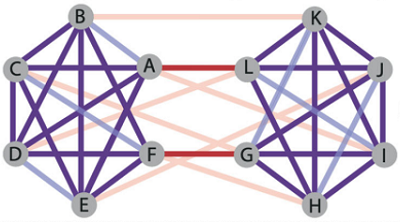HOW DOES OUR BRAIN LEARN?
In other words, how does the brain extract information from the environment, discover relevant structures and extract complexity from these structures? Among the various processes at our brain's disposal, association learning, which consists in establishing connections between cerebral representations of consecutive elements, is a well-known mechanism. Everyone knows Pavlov's reflex, a form of associative learning.
In an earlier behavioral study, the authors had shown that adults were sensitive to the high-level network structure underlying auditory sequences, even when presented with incomplete information. Their performance was explained by a mathematical model compatible with the principles of associative learning, based on the integration of transition probabilities between adjacent and non-adjacent elements.
LEARNING COMPLEX SEQUENCES OF SOUNDS
In the present study, the authors have gone a step further to demonstrate that, although elementary, this mechanism can be used to learn complex structures. To do this, they exposed participants to structured sequences of tones forming a network comprising two groups, called communities. They combined the measurement of brain activity by magnetoencephalography (MEG) with mathematical models and were able to show that, despite the uniformity of transition probabilities between tones, participants cerebral activity proved to be sensitive to the structure of the network. In particular, a coherent "deviant" response was observed at ∼150 ms when the sequence passed from one community to the other. This early difference in brain responses to transitions between two sounds indicates rapid, automatic encoding of the sequence structure. In addition, using machine learning tools, the authors were able to estimate the duration of overlap between the mental representations of each sound.

Structure of the two-community tone network. Purple lines correspond to transitions within the community, red lines to transitions between communities, and blue and pink lines correspond to transitions that were not presented to participants during habituation, within and between, respectively. Benjamin et al., J. Neurosci. 2024
In this work, the authors showed that associative learning was indeed the mechanism underlying the discovery of the structure of auditory sequences organized in a network, and shed light on the neural bases of this learning. Thus, to extract the complex structure present in a sequence of sounds, the human brain can use low-level associative processes, rather than high-level abstract representations.
Contacts : Fosca Al Roumi (fosca.alroumi@cea.fr); Lucas Benjamin (lucas.benjamin@cea.fr)
- Magnetoencephalography (MEG) is a non-invasive brain imaging technique that measures the magnetic fields generated by neurons in the human brain with high temporal and good spatial resolution.
- Associative learning is a process in which the subject learns to produce one (or more) behavioral response(s) following the perception of a stimulus, by mental association between the two.